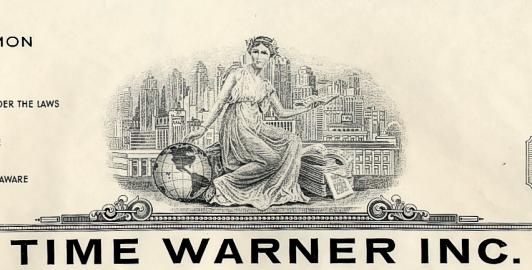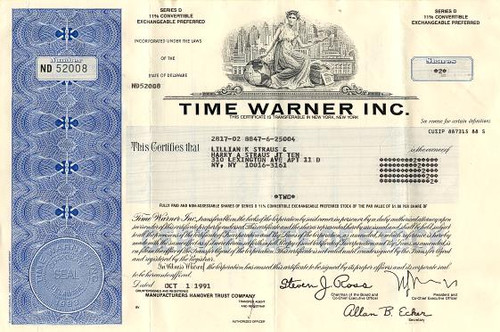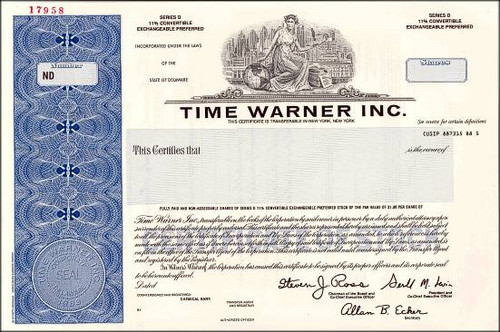Beautiful engraved RARE Specimen Proof certificate from the Time Warner Inc . This historic document was printed by United States Banknote Company and has an ornate border around it with a vignette of an allegorical woman. 
Certificate Vignette Time Warner Inc. (NYSE: TWX) is a media conglomerate headquartered in New York City, with major operations in film, television, publishing, Internet service and telecommunications. Among its subsidiaries are four major companies: Time Inc., AOL, Warner Bros. Entertainment and TBS (Turner Broadcasting System). Warner Communications was established in 1972 when Kinney National Company spun off its non-entertainment assets, due to a financial scandal over its parking operations. It was the parent company for Warner Bros. Pictures and Warner Music Group during the 1970s and 1980s. It also owned DC Comics and Mad, as well as a majority stake in Garden State National Bank (an investment it was ultimately required to sell pursuant to requirements under the Bank Holding Company Act). Initial divestiture efforts led by Garden State CEO Charles A. Agemian were blocked by Garden State board member William A. Conway in 1978; a revised transaction was later completed in 1980. Bob Kerstein went to work for Warner Bros. in 1980. Warner made considerable profits (and later losses) with Atari, which it owned from 1976 to 1984. In the 1970s, Warner expanded under the guidance of CEO Steve Ross and formed a joint venture with American Express, named Warner-Amex Satellite Entertainment, which held cable channels including MTV, Nickelodeon and Showtime. Warner bought out American Express's half in 1984, and sold the venture a year later to Viacom, which renamed it MTV Networks. In February 1983, Warner expanded their interests to baseball. Under the direction of Ceasar P. Kimmel, executive vice president, bought 48 percent of the Pittsburgh Pirates for $10 million. It then put up its share for sale in November 1984 following losses of $6 million. The team's majority owner, John Galbreath, soon followed suit after learning of Warner's actions. ([1]) In 1987, it was announced that Warner Communications and Time Inc. were to merge. The last thing Warner did before the merger closed in 1989 was to buy out Lorimar-Telepictures. In early 1990, the combined companies were named Time Warner. This company subsequently acquired Ted Turner's Turner Broadcasting System in October 1996. Time Warner had also been owner of the Six Flags Theme Parks chain during the 1990s after near bankruptcy. It sold all Six Flags parks and properties to Oklahoma based Premier Parks on April 1st, 1998. Some theme park insiders argue that Six Flags was much better off under Time Warner ownership.[citation needed] America Online merger In 2000, a new company called AOL Time Warner was created when AOL purchased Time Warner. The deal, announced in 2000, employed a merger structure in which each original company merged into a newly created entity. When the deal closed in January 2001, the shareholders of AOL owned 55% of the new company, AOL Time Warner, while Time Warner shareholders owned only 45%, meaning that AOL had effectively acquired Time Warner. The Federal Trade Commission cleared the deal on December 14, 2000, and gave final approval on January 11, 2001; the company completed the merger later that day. The deal was also approved by the Federal Communications Commission and the European Union. There has been some speculation about the motivations of each party. Some observers believed that Time Warner was struggling to integrate "new media" into its business. At the time of the announcement, Time Warner executives spoke of the need to "digitize their business." They were also eager to be attached to an dot-com company, as the dot-com bubble was near its peak. A merger with AOL provided a huge subscriber base of Internet users, along with online marketing know-how. While some business journalists have reported that AOL executives felt that AOL stock was severely overvalued and that a big merger was the only way to prevent a collapse in valuation, it is more likely that AOL executives sought to diversify the assets of the company beyond the Internet and online sectors. In addition, executives at AOL were quite concerned about the prospect of increased competition with Microsoft and sought to enlarge the company as a defensive measure. Finally, AOL executives believed that the integration of AOL's Internet distribution and Time Warner's content would create a tremendous amount of value for both sides of the company. Media companies felt that the vertically integrated AOL Time Warner would unfairly promote its own content within its outlets. This fear existed before the merger, but Time Warner was thought to be a conglomeration of very independent divisions. It was feared that this would change with the influence of AOL executives. Consumer advocates were concerned with the threat of product tying between Time Warner's cable TV systems and AOL's Internet service. Some consumer groups saw a possible attempt to corner the Internet-over-TV market, whereby AOL could force all of the Time Warner cable subscribers to use AOL branded Internet-TV. Smaller internet service providers feared that AOL would tie its Internet service to Time Warner's cable modem service. Some ISPs wanted the opportunity to use Time Warner's cable network as a common carrier for their services, which competed with AOL. AOL and Time Warner pledged not to violate any antitrust regulations. Many observers were shocked that a large, diversified media conglomerate was being acquired by a much smaller company. Market conditions at the time of the merger placed a greater premium on Internet-related stocks than on traditional media stocks. AOL's high market capitalization relative to that of Time Warner made the acquisition possible. The deal has since become a symbol of the Dot com bubble and is widely regarded as a disaster, with a $2.4 billion shareholder settlement, a further $600 million set aside and a $5 billion price boosting share buyback program announced on August 3, 2005. AOL CEO Steve Case became executive chairman of the new company, while Time Warner CEO Gerald Levin retained the CEO title. Post-merger After the merger, the profitabilty of the ISP division (America Online) decreased. Meanwhile, the market valuation of similar independent internet companies drastically fell. As a result, the value of the America Online division dropped significantly. This forced a goodwill write down, causing AOL Time Warner to report a loss of $99 billion in 2002 - at the time, the largest loss ever reported by a company. In response to the huge loss in 2002, the company dropped the "AOL" from its name, and removed Steve Case as executive chairman in favor of Richard Parsons. Case resigned from the Time Warner board on October 31, 2005.[2] Since the merger, a number of transactions have taken place: The professional wrestling company WCW was sold to competitor WWE for $7 million. The Atlanta Hawks, Atlanta Thrashers, and operating rights to Philips Arena were sold in mid-2003. The fifty percent share in the cable channel Comedy Central was sold to Viacom. Warner Music Group was sold to a group of investors led by Edgar Bronfman, Jr. in late 2003. AOL/Netscape's longrunning litigation against Microsoft was settled out of court. Time Warner announced that it was shutting down its CNNfn financial information channel and disposing of its share in Google (2004). On March 31, 2006 Time Warner sold the Time Warner Book Group to French publisher Hachette Livre, of the Lagardere group. On February 7, 2006, a group led by corporate raider Carl Icahn and Lazard Frères CEO Bruce Wasserstein unveiled a 343-page proposal calling for the breakup of Time Warner into four companies and stock buybacks totaling approximately $20 billion. On February 17, 2006, the Icahn-lead group agreed with Time Warner to not contest the re-election of TW's slate of board members at the 2006 shareholders meeting. In exchange for the Icahn group's cooperation, Time Warner will buy back up to $20 billion of stock, nominate more independent members to the board of directors, cut $1 billion of costs by 2007, and continue discussions with the Icahn group over their proposal, particularly on the future of Time Warner Cable. On February 23, 2006, Time Warner announced that Turner South, a regional sports and entertainment network in the south, will be sold to News Corp.'s Fox Cable Networks group. On September 12, 2006, Time Inc. announced that Time4 Media, a group of men's interest magazines including Popular Science and Outdoor Life was to be put up for sale. The sale will include 18 publications (including three parenting-related titles). The CW Television Network On January 24, 2006, CBS Corporation and Time Warner announced that they were to create a new broadcast network, The CW Television Network. The network officially debuted on September 18, 2006. The network formally debuted on September 20 with the 2 hour premiere of America's Next Top Model. The network is the result of a merger of The WB Television Network (a Time Warner holding) and UPN (a CBS Corporation holding). CBS Corporation and Time Warner will each own 50% of the network. Tribune Broadcasting (previously owned a 25% stake on The WB) and CBS Corporation will contribute its stations as new network affiliates. Time Warner Cable has since reexpanded and offers the following services: Road Runner High-Speed Online - Time Warner's residential- and commercial-grade high-speed Internet service provider Time Warner Cable - features advanced video technologies such as Video On Demand and digital video recorders Digital Phone - an unlimited local and long distance telephone service that runs over the Time Warner Cable hybrid fiber-coax network.
About Specimens Specimen Certificates are actual certificates that have never been issued. They were usually kept by the printers in their permanent archives as their only example of a particular certificate. Sometimes you will see a hand stamp on the certificate that says "Do not remove from file". Specimens were also used to show prospective clients different types of certificate designs that were available. Specimen certificates are usually much scarcer than issued certificates. In fact, many times they are the only way to get a certificate for a particular company because the issued certificates were redeemed and destroyed. In a few instances, Specimen certificates we made for a company but were never used because a different design was chosen by the company. These certificates are normally stamped "Specimen" or they have small holes spelling the word specimen. Most of the time they don't have a serial number, or they have a serial number of 00000. This is an exciting sector of the hobby that grown in popularity over the past several years.

Certificate Vignette
About Specimens Specimen Certificates are actual certificates that have never been issued. They were usually kept by the printers in their permanent archives as their only example of a particular certificate. Sometimes you will see a hand stamp on the certificate that says "Do not remove from file". Specimens were also used to show prospective clients different types of certificate designs that were available. Specimen certificates are usually much scarcer than issued certificates. In fact, many times they are the only way to get a certificate for a particular company because the issued certificates were redeemed and destroyed. In a few instances, Specimen certificates we made for a company but were never used because a different design was chosen by the company. These certificates are normally stamped "Specimen" or they have small holes spelling the word specimen. Most of the time they don't have a serial number, or they have a serial number of 00000. This is an exciting sector of the hobby that grown in popularity over the past several years.








